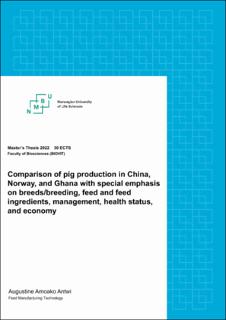| dc.description.abstract | This thesis give a comparison of pig production in China and Norway both temperate countries and Ghana (tropical country) with special emphasis on breed/breeding, feed and feed ingredients, health status, management and economy was undertaken. The objective of Comparing pig production in the three countries was to learn how production take place in each country, to reveal the strengths and weaknesses/barriers of each country and to suggest appropriate means of improving on production based on comprehensive study of the appropriate literature of the three countries.
The study showed that (i) The dominant local breeds are ADP in Ghana, TaiHu and Meishan in China and Norwegian Landrace in Norway. The exotic breeds are similar in the three countries (Large white, Landrace, Duroc, Hampshire and others). (ii) Breeding programmes in Norway are more advanced and purposeful, supportive and productive than in China and Ghana. (iii) Swine disease surveillance, veterinary services and biosecurity protocols are excellent in Norway, good in China and satisfactory in Ghana, leading to no swine diseases in Norway except A(H1N1)pdm09 but several swine diseases in China and Ghana including the deadly ASF which has claimed a lot of lives and caused massive culling of pigs. The result is that China with the largest population of pigs (700 million herds) and Ghana (759,000 herds) are net importers than exporters of pork and Norway regulates the production to cover national consumption (1700 herds). (iv) Commercial pig producers in the three countries used commercial prepared feed. Both Chinese and Ghanaian peasant farmers use locally available and cheap feed materials to feed pigs. Norway only use compound feed with fishmeal, imported soybean and rapeseed as protein sources and Norwegian produced grain. (v) China uses skyscraper to accommodate pigs because of the large number of pigs. Norway and China manipulate their sties to ensure the creation of thermoneutral zones for pigs because of extremes of temperature during winter and summer. Ghana uses Open yard sties with partial roofing and dwarf walls as well as Shades, sheds, yards and stalls.
Swine market in Norway is more stable than in Ghana and China because the production is regulated by involvement of Norwegian government. In Norway, the strengths of the production are effective control of diseases and pest except A(H1N1)pdm09, effective coordination and integration (networking) of all levels of production – commercial, medium scale and small scale, effective enforcement of laws in the sale of fresh pork at only designated points/places, high governmental involvement in the swine industry regarding production volumes, pricing and the curtailment of the activities of middlemen and zero online sale of fresh pork. Weakness is high import of feed ingredients. The strengths of the production in Ghana is the effective use of ADP in breeding programmes, the use of baobab leafmeal to feed pigs, and cheaper buildings for production. Weakness is less effective production and partly regulated sales system. China have very effective production, effective breeding programmes, and use of skyscraper is a preserve and is the largest importer of pork even though she is the home to the largest population of pigs. Weakness is large concentration of pigs and high risk of disease. | |
